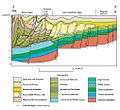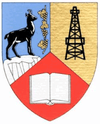Ploiești
Ploiești (UK: /plɔɪˈɛʃti/, US: /plɔːˈjɛʃt(i)/,[4][5][6][7] Romanian: [ploˈjeʃtʲ]), formerly spelled Ploești, is a city and county seat in Prahova County, Romania.
Ploiești | |
|---|---|
Left to right: Nicolae Simache Clock Museum, St. John the Baptist Cathedral, the former Creditul Prahovei, the Ghiță Stoenescu House, the Radu Stanian House. | |
| Nickname(s): Capitala Aurului Negru (English: Capital of Black Gold) | |
 Location in Prahova County | |
 Ploiești Location of Ploiești within Romania | |
| Coordinates: 44°56′N 26°2′E | |
| Country | |
| County | |
| Status | County seat |
| Government | |
| • Mayor | Adrian-Florin Dobre[1] (PNL) |
| Area | |
| • City | 58.28 km2 (22.50 sq mi) |
| Elevation | 160 m (520 ft) |
| Population (2011 census)[2] | |
| • City | 209,945 |
| • Estimate (2016)[3] | 233,663 |
| • Density | 3,394/km2 (8,790/sq mi) |
| • Metro | 266,4571 |
| Time zone | UTC+2 (EET) |
| • Summer (DST) | UTC+3 (EEST) |
| Postal code | 100xxx |
| Area code(s) | (+40) 44 |
| Car plate | PH |
| Website | www |
| 1 Ploiești metropolitan area is a proposed project. | |
Part of the historical region of Muntenia, it is located 56 km (35 mi) north of Bucharest. The area of the city is around 60 km2. It borders the Blejoi commune in the North, Bărcănești and Brazi communes in the South, Târgșoru Vechi in the West and Bucov and Berceni communes in the East. Ploiești has direct access to the Prahova Valley, one of the most important alpine tourism areas in Romania.
Ploiești is an important transport hub, linking Bucharest with Transylvania and Moldavia. According to the 2011 Romanian census, there were 201,226 people living within the city of Ploiești, making it the 9th most populous in the country.
History
(monthly metric tonnes):[8]
- Astra Romania (146,000)
- Colombia Aquila (45,000)
- Concordia Vega (110,000)
- Creditul Minier (45,000)
- Dacia Romana (15,000)
- Phoenix (65,000)
- Romana Americana (92,000)
- Standard Petrol Block (36,000)
- Unirea Sperantza (33,000)
- Xenia (22,000)
Though likely settled much earlier, Ploiești first appeared in documents in the 16th century, during the reign of Mihai Viteazul (Michael the Brave), Prince of Wallachia (r. 1593–1601). It flourished as a center for trade and handicraft-manufacturing in the 17th and 18th centuries. The road connecting Ploiești to Brașov opened in 1864, and the railway arrived in 1882. Many schools and hospitals date from this time.
In the mid-19th century the Ploiești region became one of the world's leading oil extraction and refinery sites. The Mehedințeanu brothers opened the world's first large refinery[9] at Ploiești in 1856–1857. History also remembers the city as the site of the self-styled Republic of Ploiești, a short-lived 1870 revolt against the Romanian monarchy.
During World War I Ploiești's oil production made it a target when the Central Powers invaded Romania in 1916, but a British Army operation under John Norton-Griffiths destroyed production and sabotaged much of the infrastructure of the industry.[10]
World War II
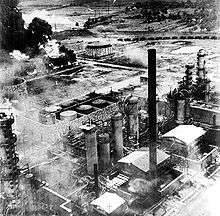
Although badly damaged after the November 1940 earthquake, the city was a significant1 source of oil for Nazi Germany during much of World War II. The Allies made Ploiești a target of the oil campaign of World War II and attacked it repeatedly,[11] such as during the HALPRO (June 1942) and Operation Tidal Wave (1 August 1943) at a great loss, without producing any significant delay in operation or production. Soviet troops captured Ploiești in August 1944.
Following the war, the new Communist régime of Romania nationalised the oil industry, which had largely been privately owned, and made massive investments in the oil and petroleum industry in a bid to modernise the country and to repair the war damage.
Demographics
| Year | Pop. | ±% |
|---|---|---|
| 1810 | 2,024 | — |
| 1859 | 26,468 | +1207.7% |
| 1899 | 45,107 | +70.4% |
| 1912 | 56,460 | +25.2% |
| 1930 | 79,149 | +40.2% |
| 1941 | 107,068 | +35.3% |
| 1948 | 95,632 | −10.7% |
| 1956 | 114,544 | +19.8% |
| 1966 | 146,922 | +28.3% |
| 1977 | 199,699 | +35.9% |
| 1992 | 252,715 | +26.5% |
| 2002 | 232,527 | −8.0% |
| 2011 | 209,945 | −9.7% |
| Source: Census data, 1930–1948.[12] | ||
The population of Ploiești went from 56,460, as indicated by the December 1912 census returns, up to 252,715 in January 1992. Since the fall of Communism, however, the city's population continues to gently fall due both to emigration and to a declining birth rate. At the 2002 census, the population reduced to 232,527.[13] As of 2011 census data, Ploiești has a population of 197,542, while the proposed Ploiești metropolitan area would have a population of 266,457.[2]
The majority of the inhabitants are Romanians (90.64%), but a Roma minority (2.4%) is also present in several neighborhoods of the city, predominantly in Bereasca, Mimiu and Radu de la Afumați.[14] For 6.65% of the population, the ethnicity is unknown.[15] Most of the people living in Ploiești are Orthodox Christians (90.7%).[16]
Historical trends
The population of Ploiești grew at a rapid pace because of the intense economic development of the area. In 1810, during the years of the Ottoman occupation there were only around 2024 inhabitants in the present-day city. In 1837 this grew to 3,000 inhabitants, 11 years after the Union in 1859 the population was 26,458 while in 1884 the number stood at 32,000. During the early 20th century, the population of Ploiești grew even more, due to the expansion of the petrol industry. Even though the city was bombed during the World War II, the population of Ploiești recovered, numbering 95.632 inhabitants in January 1948.
| Census | Ethnic composition | ||||||||||
|---|---|---|---|---|---|---|---|---|---|---|---|
| Year | Population | Romanians | Hungarians | Germans | Serbs | Jews | Romani | Russians | Greeks | Ukrainians | |
| 1930 | 79,149 | 69,139 | 1,591 | 1,307 | |||||||
| 2011 | 201,226 | 199,221 | 109 | 69 | - | - | 1289 | 44 | - | 8 | |
Economy
.jpg)
After the Romanian Revolution of 1989, Ploiești experienced rapid economic loss due to bad government and investments from foreign companies. The city is situated at just 60 km (37 mi) north of Bucharest, with promising infrastructure projects currently underway. It is a strong industrial center, focused especially on the oil production and refining industry. Although oil production in the region is declining steadily, there is still a thriving processing industry with four operating oil refineries, linked by pipelines to Bucharest, the Black Sea port of Constanța and the Danube port of Giurgiu. Ploiești also has a long history as a textile manufacturing center.
The city has become a hub of foreign investment. Companies such as OMV-Petrom, Lukoil, Shell Gas, Timken, Yazaki, Coca-Cola, Efes Pilsener, British American Tobacco, Federal-Mogul, and Interbrew have operations there, and retailers like Carrefour, Metro, Selgros, Kaufland, Billa, Bricostore, Lidl, Obi, Auchan, Profi, Mega Image have found in Ploiești a continuously growing market, but the pay rate for employees is lower than expected. There are four McDonald's restaurants in Ploiești and three KFCs.
The German retailer Tengelmann built a depot in Ploiești to support a €200 million regional expansion plan. With its Interex (ro) operation, the French independent retailer Intermarché intends to become a distribution leader in the Balkans. In Romania the first Interex store was opened in June 2002 in Ploiești. The Interex depot and facilities were bought by Penny Market XXL in 2014.[17]
Unilever has a detergent plant in Ploiești. By transferring their food production to Ploiești, the company will concentrate all its activities in Romania at the same location. At the beginning of March 2006, Unilever announced they would invest money to build one production center in Romania, and the construction of the new food plant is part of this plan.[18]
In 1950, as a milestone in the development of the petroleum, hydrocarbon processing, and petrochemical industries, the Engineering and Design Institute for Oil Refineries and Petrochemical Plants, SC IPIP SA, a Romanian company with a large range of capabilities and experience, was established at Ploiești.
In Ploiești there are four local television channels: Ploiești TV, Valea Prahovei TV, Wyll TV and Prahova TV.
Transportation
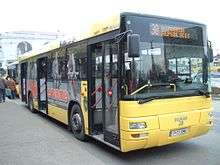
Ploiești is situated on the A3 motorway (partially completed as of Spring 2014),[19] the main route to Romania's northern and western provinces and the Western EU. Henri Coandă International Airport is 45 km (28 mi) distant, and the ski resorts of the Prahova Valley can be reached in an hour's drive. Ploiești is the second most important railway center in the country after Bucharest, linking Bucharest with Transylvania and Moldavia. The city's public transportation system is run by TCE Ploiești and includes an extensive network of buses, trolleybuses and trams/streetcars. Ploiești's distinctive yellow bus fleet is one of the most modern in Southeastern Europe, providing connections to all areas within the city, for a daily average of 150,000 passengers. The municipal roads comprise over 800 streets with a total length of 324 km (201 mi), 241 km being modern. Around 5,300 vehicles transit Ploiești each day, with East and West ring belts diverting much traffic. The municipal vehicle fleet comprised 256 buses, 36 trams and 25 trolleybuses carrying about 70 millions passengers annually. There are 33 bus lines, with a total length of 415.46 km (258.15 mi); two trolley-bus lines having a total length of 19.9 km (12.4 mi) and two tram lines having a total length of 23.8 km (14.8 mi).
Culture
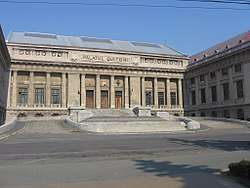
Ploiești is home to the Ploiești Philharmonic Orchestra—one of the top-rated philharmonic orchestras in Romania, a prominent football club, FC Petrolul Ploiești, women handball club CSM Ploiești from Liga Națională and basketball team CSU Asesoft.
There are many cultural and architectural monuments, including the Cultural Palace; the Clock Museum, featuring a collection of clocks and watches gathered by Nicolae Simache; the Oil Museum; the Ploiești Art Museum, donated by the Quintus family; and the Hagi Prodan Museum, dating to 1785: the property of a merchant named Ivan Hagi Prodan, it contains elements of old Romanian architecture and for a short time after World War I it hosted the first museum in Ploiești, "Prahova Museum". In August 2011, Ploiești hosted the Golden Carpathian European Film & Fair and Goran Bregovic concert.
Several prominent writers have been affiliated with the city, including Ion Luca Caragiale, Constantin Dobrogeanu-Gherea, Ioan A. Bassarabescu, Nichita Stănescu, Geo Bogza, Radu Tudoran, composer Paul Constantinescu and philosopher Petre P. Negulescu. Three graduates of the "Sfinții Petru și Pavel" High school were presidents of the Romanian Academy: Andrei Rădulescu, Mihai Drăgănescu and Eugen Simion.
Education
The first school in Ploiești was opened in 1777 and by 1832 several other elementary schools are opened. Secondary education is first offered in 1864.
Ploiești is home to the following universities and colleges:
Important secondary schools in Ploiești are:
- Mihai Viteazul National College
- I.L. Caragiale National College
- National College "Jean Monnet"
- Virgil Madgearu Economic College
- Spiru Haret High school
- Al. Ioan Cuza National College
- Nichita Stănescu National College
- Lazar Edeleanu Technical College
- Carmen Sylva National College (Liceul de artă)
- Constantin Brâncoveanu Military School
- Toma N. Socolescu Highschool
Geology
The Mio-Pliocene Zone in the Ploiești region has been exploited for hydrocarbons and coal since the 19th Century.[22] The zone extends from the flysch on the north to the Moesian Platform on the south.[23] The zone is marked by alternating deposits of Clay, Marl, Shale and Sand, conglomerate, Salt and Limestone.[24] Structural traps and stratigraphic traps are formed from Salt Diapirism which gave rise to anticline folds and faulting.[24] There are four major alignments of the anticlines, all parallel to the Carpathian Range.[24] Pliocene sands are the main oil and gas producers, in particular the Meotian (60%) and Dacian (29%), followed by the Miocene Sarmatian (5%) but some oil exists in Miocene Helvetian and Oligocene sandstones.[25] Major producing structures include Moreni-Gura Ocniței, Băicoi-Țintea and Boldești.[24]
Geography
Ploiești lies in the center of Muntenia, in the central-northern part of the Romanian Plain. It lies close to the capital city Bucharest and it had close connections with the capital city throughout the centuries. Ploiești lies at the 25°E meridian and the 44°55’N parallel (north). The city occupies a total surface of around 60 km2, out of which 35 km2 is suburban settlements. There exist two rivers in the proximity of the city: Prahova river, on the south-west, briefly passes through the city through the Brazi settlement and Teleajen River passes through the Blejoi, Bucov, Berceni villages. The city lies on Dâmbu River, which springs from the hills around the Băicoi town. Nowadays the Dâmbu River doesn't have a high flow rate.
Nearest towns
| Town | Direction | Distance | ||
|---|---|---|---|---|
| straight-line distance | road distance | rail distance | ||
| Bucharest | S | 56 km | 60 km | 59 km |
| Brăila | E | 155 km | 170 km | 176 km |
| Pitești | W | 91 km | 111 km | 149 km |
| Brașov | NW | 86 km | 114 km | 110 km |
| Târgoviște | V | 46 km | 51 km | 52 km |
| Buzău | NE | 66 km | 71 km | 69 km |
| Urziceni | SE | 55 km | 60 km | 55 km |
Climate
The climate is similar to that of the nation's capital, Bucharest. According to the Köppen climate classification, the city falls within the temperate humid continental climate(Dfa) of the hot summer type. The average annual temperature is 10.5 °C, with record minimum registered on 25 January 1952 of -30 °C while record maximum was registered on 19 July 2007 of 43 °C. On average, around 17 days are very cold, 26 cold, 99 warm and 30 tropical, while the rest have a moderate temperature.
Average annual precipitations are 600 mm; 30–40 mm in January and 88 mm in June. Precipitations range between 963.9 mm registered in 1901 and 305.3 mm registered in 1930. Throughout the year, there are on average 104 days with rain, 26 with snow, 112 with clear skies, 131 with clouds and 122 with no sunshine. The climate of Ploiești is influenced by the winds coming from north-east (40%) and south-east (23%), having an average speed of 3.1 m/s. On average, there are 11 days throughout the year with wind speed exceeding 11 m/s and only 2 days characterised by winds over 16 m/s. Atmospheric pressure is 748.2 mm.
| Climate data for Ploiești | |||||||||||||
|---|---|---|---|---|---|---|---|---|---|---|---|---|---|
| Month | Jan | Feb | Mar | Apr | May | Jun | Jul | Aug | Sep | Oct | Nov | Dec | Year |
| Average high °C (°F) | 1 (34) |
4 (39) |
10 (50) |
18 (64) |
23 (73) |
27 (81) |
28 (82) |
28 (82) |
24 (75) |
18 (64) |
10 (50) |
3 (37) |
16.2 (61.2) |
| Average low °C (°F) | −6 (21) |
−3 (27) |
0 (32) |
6 (43) |
10 (50) |
14 (57) |
16 (61) |
15 (59) |
11 (52) |
6 (43) |
1 (34) |
−3 (27) |
5.6 (42.1) |
| Average precipitation mm (inches) | 40.6 (1.60) |
35.6 (1.40) |
38.1 (1.50) |
45.7 (1.80) |
71.1 (2.80) |
76.2 (3.00) |
63.5 (2.50) |
58.4 (2.30) |
43.2 (1.70) |
33 (1.3) |
48.3 (1.90) |
43.2 (1.70) |
596.9 (23.50) |
| Source: Weather Channel | |||||||||||||
Landscape and flora
The city lies on the Romanian Plain, having an average altitude of 150m. The surrounding landscape is influenced by its position around the Prahova river, whose stream bed lies 25 km west. The Teleajen River passes through the city while the Dâmbu River passes through the north-eastern neighbourhoods.
The vegetation of Ploiești used to be characterised by a plain forest, made up predominantly of pedunculate oak trees (Quercus robur). Other varieties of oak trees such as the sessile oak (Quercus petraea) also existed. Remnants of the old forest still exist and some trees are currently protected, such as two old oak trees in Ghighiu, on the southern periphery of the city.
In current times the vegetation is typical of urban settlements, made up of ornamental plants, plantations of chestnuts, aspen and black locust. Parks and other green areas are limited: the main boulevard area, the park next to the Sala Sporturilor, the park from the northern part of the city, the "Mihai Viteazul" park and another park next to the Bucov barrier. These occupy only around 85.5 ha, resulting in 3.2 m2 of green space per inhabitant.
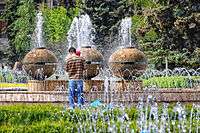
Around the city one can also observe several endangered trees, which are protected by law. These include the giant redwood (Sequoiadendron giganteum) from the garden of the "Paul Constantinescu" museum. There also exist trees that have adapted to the local climate, such as figs. In some neighbourhoods more fruit trees and flowers are currently being planted.
Politics
The Ploiești City Council, elected in the 2016 local elections, is made up of 27 councillors, with the following party composition:
| Party | Seats | Current Council | |||||||||||
|---|---|---|---|---|---|---|---|---|---|---|---|---|---|
| Social Democratic Party | 11 | ||||||||||||
| National Liberal Party | 10 | ||||||||||||
| Alliance of Liberals and Democrats | 4 | ||||||||||||
| People's Movement Party | 2 | ||||||||||||
There exist approximatively 88,104 flats that are located in 21,172 buildings. 93% of the households have access to clean water, 90% have access to the sewage network, 98% have access to electricity and 78% are connected to the district heating system.
Metropolitan area
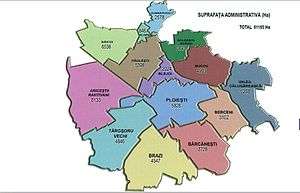
The metropolitan area of Ploiești comprises 13 satellite towns. The area will become an important transit for two Pan-European motorway and rail corridors. The central administration of the area will coordinate the communication and transport networks, technological development and the reduction of the carbon footprint.
International relations
Natives
- Sports: Octavian Belu, Alexandru Dedu, Adrian Diaconu, Leonard Doroftei, Laurențiu Toma, Tamara Costache
- Architecture: Toma T. Socolescu
- Politics: Alexandru Dobrogeanu-Gherea, Ștefan Gheorghiu (trade unionist), Take Ionescu, Corneliu Mănescu, Istrate Micescu, Remus Opriș, Mircea Ionescu-Quintus
- Academia: Liviu Librescu, Nicolae Simache, Mihai Drăgănescu, Eugen Simion
- Literature: Lucian Avramescu, Nichita Stănescu, Ion Stratan
- Science: Carol Nicolae Debie, Basarab Nicolescu, Antarés Pârvulescu
- Music: Andreea Bălan, Ovidiu Bălan, Leonida Constantin Brezeanu, Nico, Cezar Ouatu
- Theater and Film: Denis Stefan, Toma Caragiu
Gallery
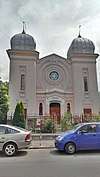 Synagogue
Synagogue- School of Arts and Crafts
 St. George belfry
St. George belfry- St. John the Baptist Cathedral
- Museum of History and Archaeology
- Nicolae Simache Clock Museum
- Central Market Hall
- Holy Voivodes Church
See also
Notes and references
- ^1 Sources provide differing estimates regarding Romanian production:
- 1942: The Axis Oil Position in Europe, November 1942 by the Hartley Committee estimated that "Romanian oil fields" contributed 33% of Axis supplies.[31]
- 1944: "Ploiești, thirty-five miles (8.0 km) from Bucharest, supplied one-third of all the oil fuel Germany required for war purposes."[32]
- 1999: The fragile, concentrated Bucharest facilities provided "60% of Germany's crude oil supply"[33]
- "Results of the 2016 local elections". Central Electoral Bureau. Retrieved 3 April 2020.
- "2011 Census press release" (PDF) (in Romanian). INSSE Prahova. February 2, 2012. Archived from the original (PDF) on August 1, 2013. Retrieved March 10, 2012.
- "Populaţia României pe localitati la 1 ianuarie 2016" (in Romanian). INSSE. 6 June 2016. Archived from the original on 2017-10-27. Retrieved 3 November 2017.
- "Ploiesti". The American Heritage Dictionary of the English Language (5th ed.). Boston: Houghton Mifflin Harcourt. Retrieved 20 May 2019.
- "Ploeşti". Collins English Dictionary. HarperCollins. Retrieved 20 May 2019.
- "Ploiești" (US) and "Ploieşti". Oxford Dictionaries UK Dictionary. Oxford University Press. Retrieved 20 May 2019.
- "Ploiesti". Merriam-Webster Dictionary. Retrieved 20 May 2019.
- "U.S. Air Force photo" [sic] [diagram] in Gurney, Gene (Major, USAF) (1962). "The War in the Air: a pictorial history of World War II Air Forces in combat". New York: Bonanza Books: 121. Cite journal requires
|journal=(help) - "WORLD EVENTS: 1844-1856". PBS.org. Archived from the original on 2017-07-05. Retrieved 2009-04-22.
world's first oil refinery
-
Burg, David F. (2010). Almanac of World War I. L. Edward Purcell. University Press of Kentucky. p. 336. ISBN 9780813137711. Retrieved 2012-10-29.
7 December 1916 [...] Falkenhayn's Ninth Army turns to the north in hopes of capturing the oil fields and refineries at Ploesti, but Falkenhayn is too late: John Norton-Griffiths has done his work. The oil fields at Ploesti, Targoviste, and elsewhere are aflame and their refining facilities in ruins - a severe loss to the German war effort, as it will be months before production can be restored.
- Video: American Bombers Smash Axis Oil Fields In Romania Etc. (1943). Universal Newsreel. 1943. Archived from the original on September 22, 2012. Retrieved February 21, 2012.
- Populatia RPR la 25 ianuarie 1948, p. 14
- "2002 Census". Archived from the original on 2012-03-30. Retrieved 2010-06-13.
- "Palatele țigănești din Ploiești, luxul răzleț din cartierele sărace de romi" [Gyspsy palaces of Ploiești, the luxury within poor roma neighborhoods]. Adevărul (in Romanian). 30 January 2013. Archived from the original on 11 April 2017. Retrieved 11 April 2017.
- 2011 census results: "Tab8. Ethnicity data – counties, cities and villages". National Institute of Statistics - România. July 2013. Archived from the original on 2015-09-24. Retrieved 2013-08-05.
- 2011 census results: "Tab13. Ethnicity data – counties, cities and villages". National Institute of Statistics - România. July 2013. Archived from the original on 2013-09-21. Retrieved 2013-08-05.
- "Penny Market XXL, pe locul fostului magazin Interex Ploiești". Adevarul.ro. Archived from the original on 2014-04-08. Retrieved 2014-04-08.
- Bucharest Business Week, Unilever builds factory in Ploiești Archived 2009-01-10 at the Wayback Machine, March 10, 2006
- 'A3 Motorway Bucharest-Bors', retvd 4 12 14; http://130km.ro/a3_en.html Archived 2014-04-13 at the Wayback Machine
- "www.upg-ploiesti.ro/". Archived from the original on 2020-01-18. Retrieved 2020-02-04.
- "www.universitateagbaritiu.ro/index.php?option=com_content&view=article&id=68&Itemid=385". Archived from the original on 2014-04-09. Retrieved 2014-04-08.
- Paraschiv, P., and Olteau, G., Oil Fields of Ploiești District, Romania, in Geology of Giant Petroleum Fields, AAPG Memoir 14, Halbouty, M.T., editor, Tulsa: American Association of Petroleum Geologists, 1970, p. 401.
- Paraschiv, P., and Olteau, G., Oil Fields of Ploiești District, Romania, in Geology of Giant Petroleum Fields, AAPG Memoir 14, Halbouty, M.T., editor, Tulsa: American Association of Petroleum Geologists, 1970, p. 399.
- Paraschiv, P., and Olteau, G., Oil Fields of Ploiești District, Romania, in Geology of Giant Petroleum Fields, AAPG Memoir 14, Halbouty, M.T., editor, Tulsa: American Association of Petroleum Geologists, 1970, p. 425.
- Paraschiv, P., and Olteau, G., Oil Fields of Ploiești District, Romania, in Geology of Giant Petroleum Fields, AAPG Memoir 14, Halbouty, M.T., editor, Tulsa: American Association of Petroleum Geologists, 1970, p. 415.
- Pawlewicz, M., Total Petroleum Systems of the Carpathian-Balkanian Basin Province of Romania and Bulgaria, US Dept. Interior USGS Bulletin 2204-F, 2007, p. 9
- Pawlewicz, M., Total Petroleum Systems of the Carpathian-Balkanian Basin Province of Romania and Bulgaria, US Dept. Interior USGS Bulletin 2204-F, 2007, p. 6
- Pawlewicz, M., Total Petroleum Systems of the Carpathian-Balkanian Basin Province of Romania and Bulgaria, US Dept. Interior USGS Bulletin 2204-F, 2007, p. 5
- "Radom - Miasta partnerskie" [Radom - Partnership cities]. Miasto Radom [City of Radom] (in Polish). Archived from the original on 2013-04-03. Retrieved 2013-08-07.
- "Radom - miasta partnerskie" (in Polish). radom.naszestrony.pl. Archived from the original on 2007-07-26. Retrieved 2013-08-07.
-
US Secretary (January 1943). Casablanca Conference: Papers and Minutes of Meetings. Dwight D. Eisenhower Presidential Library; COMBINED CHIEFS OF STAFF: Conference proceedings, 1941–1945; Box 1: Office of the Combined Chiefs of Staff. pp. 40–43, 88, 256.
Brehon Somervell[inside front cover] … DECLASSIFIED … 10/29/73 … U.S. SECRET … BRITISH MOST SECRET … COPY NO. 32[inside back cover]
CS1 maint: location (link) - Turner, S.J., F. R. G. S -- maps (1944). Vol. 2 [September 3, 1941—August 15, 1943]. Pictorial History of the Second World War. Wm. H. Wise & Co., Inc. pp. 519–1020 [986].
- Modrovsky, Robert J. (April 1999). 1 August 1943 -- Today's Target is Ploesti: A Departure from Doctrine. p. 4.
External links
- (in English and Romanian) Website of the town hall of Ploiești
- (in Romanian) RepublicaPloiești.net is a site specializing in architectural history of the City of Ploiești. It contains numerous photographs of the city taken between the beginning of the twentieth and 1945.
- Tramway in Ploiești
- (in Romanian) Map of Ploiești with route planning, points of interest, public transport
| Wikimedia Commons has media related to Ploiești. |


